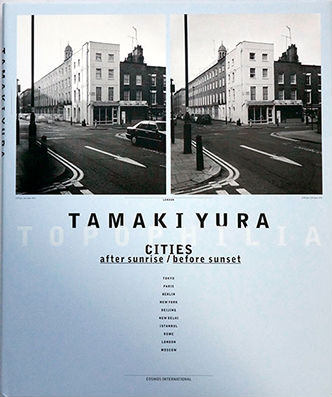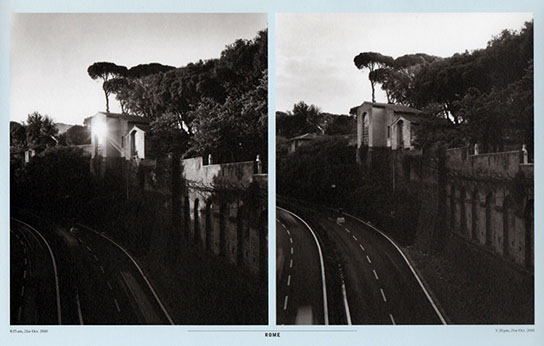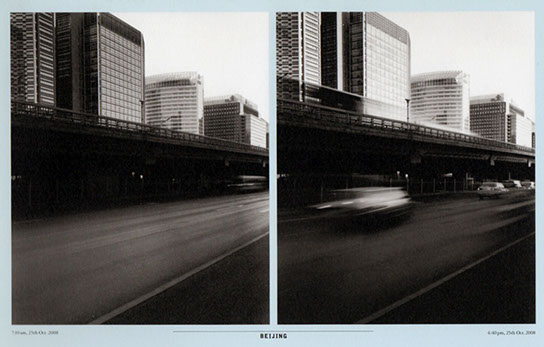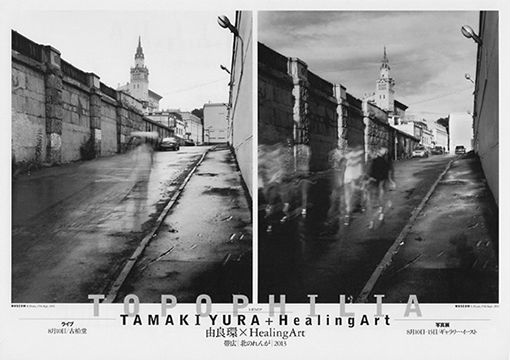Tamaki Yura
TOPOPHILIA cities after sunrise / before sunset
Afterword
Tamaki Yura
Topophila is “the affective bond between people and place or setting,” which is “diffuse as concept, vivid and concrete as personal experience,” writes Yi-Fu Tuan(*1), the author of the book Topohilia(*2). Tuan also writes, “However, it does – perhaps for the first time present a general framework for discussing all the different ways that human beings can develop a love of place.”
I had the intuitive feeling that the act of “photographing ten cities by the same methodology(*3),” which I have worked on for many years, and the pliable and unique definition of “Topophilia,” advocated by Yi-Fu Tuan, essentially mean the same thing.
The photographs that comprise this work present a variety of contrasts, which stimulate the viewer to observe and analyze different aspects of the cities. It is nothing but a result of my strong wish for the message of this work to have a positive perspective on what is called “city.”
In 2005, I started this photographic work as an attempt for comparative urban study of Tokyo and Paris. After that, I planned to choose and shoot eight more cities from all over the world (ten cities in total including Tokyo and Paris) by the same methodology. Through photographing the ten megalopolises, I intended to capture various examples of regularity, generality, and unpredictability that all cities in the world have in common. To achieve this purpose, I thought that at least ten cities would be needed, so that enough data could be gathered.
I then searched, on the world map, different megalopolises each of which contained a loop line surrounding the center that serves as the basis of development of its urban structure. From the candidates, I selected ten cities equitably from Asia, Europe, and the North America, which seemed to symbolize the past, the present, and the future (However, I have to admit that this selection actually has turned out bearing inequality to some degree).
At that time, the eight cities other than Tokyo and Paris were places I had never been to. And, in each of them, I stayed for about a month (or a little more).
The life I led in the city was quite simple. I would take photos once in the morning, and once in the evening. During the day, I would make preliminary inspections for upcoming photo locations, otherwise I walked intently through the town. By putting myself in the street, and in the crowd whenever possible, I was able to feel the air with my skin, trying to sharpen my senses. Based on “the same methodology,” which I myself had set, this was my solution of how to transform the city into the form of photographic expressions. It was also a way to somehow deal with the most important theme: how to make photographs take on emotions, sensations, and passions, and convey the actual atmosphere of the site vividly, under such strict regulation.
Due to the use of “the same methodology,” the contrast between the ten cities has been brought out very clearly. Each city is composed of a lot of different elements interwoven, yet photographing them from the same angle made it possible to capture their characteristics and uniqueness very vividly.
New York was built with London as its model, in terms of the urban structure and building design. Also, it was an English architect who designed “Connaught Place,” a symbolic area in the city of New Delhi. In the center of the area is a huge circular plaza, from which roads radiate outward and so the city spreads along the lines. However, what I found outstanding, regardless of this structure, was how clearly the city's residential areas were segmented for the rich and the poor. It seemed like the epitome of a hierarchical society, through which I felt the reality of the city with my skin.”
Belongings and clothes of Tokyoites are quite similar to those of New Yorkers. Fast food restaurants and coffee shops from the same chains are lined in the almost same way on the street in the two cities. By comparing the two cities, I belatedly re-realized that the current situation of Tokyo is a historical result of the war defeat and the consequent ruling of the US.
In each city, it was only at the end of my one- month stay that I could grasp the meaning of what it had shown me. Until then, only clues were given to me, which would then gradually pile up toward a full realization. I found every city full of various elements in relation to history, war, ethnics, culture, and politics. It was such a big surprise for me that my work seemed to illuminate them so vividly.
Having finished photographing the ten cities, I now look over the resultant photographs. Each incorporates my perspective that I had built of the city, as well as presents an agglomeration of various aspects of the city as a whole.
April 2012
*1: “Topophilia: Study of Environmental Perception, Attitudes
and Values” was written by Yi-Fu Tuan and published in the US and Europe in 1974. The Japanese edition was published by Serika Shobo in 1992, translated by Yugo Ono and Hajime Abe. It was then re-published by Chikuma Shobo as part of Chikuma Gakugei Bunko series in 2008.
*2: Born 1930, Tientsin, China. He is a Chinese-born American geographer who advocated “humanistic geography” and “phenomenological geography.”
*3: The methodology is as follows. Photographs are taken in spring or autumn (though in some cities this was not applied) at approximately 25 spots (25 days), more or less along the city's main loop line (road, railway, castellated wall, etc.), with the camera pointing toward the city center. Each day, the times are an hour after the sunrise, and an hour before the sunset. The camera is kept in a horizontal position at the height of 1.6 meters from the ground. Equipment and setting used: 4 x 5 inch field camera / Kodak TXP 320 / 150 mm lens / aperture F45.





Tamaki Yura TOPOPHILIA cities after sunrise/before sunset
LONDON 5:55 am, 2nd June 2011 [ left], 8:00 pm, 2nd June 2011 [right]
NEW DELHI
ROME
BEIJING
Exhibition DM
MOSCOW 8:20 am, 17th Sept. 2011 [left], 6:45 pm, 17th Sept. 2011
|<<
>>|
1 - 5
<
>
Size: 316×265mm / Pages: 160 / Hard Cover / Price: Yen 6,000+tax
Published on July. 18, 2012. / Publisher: COSMOS INTERNATIONAL INC.
©
Studio Ray since 2008